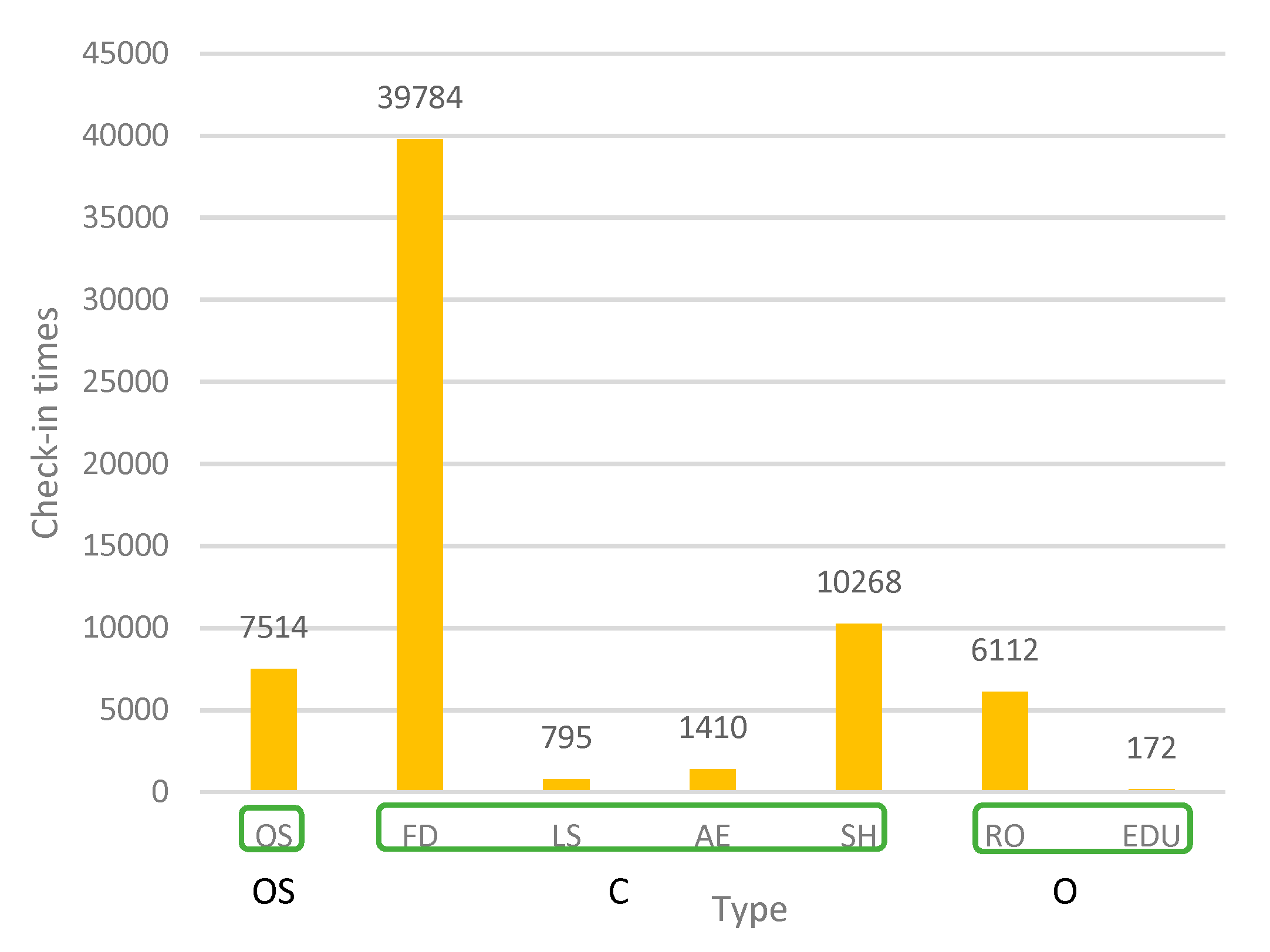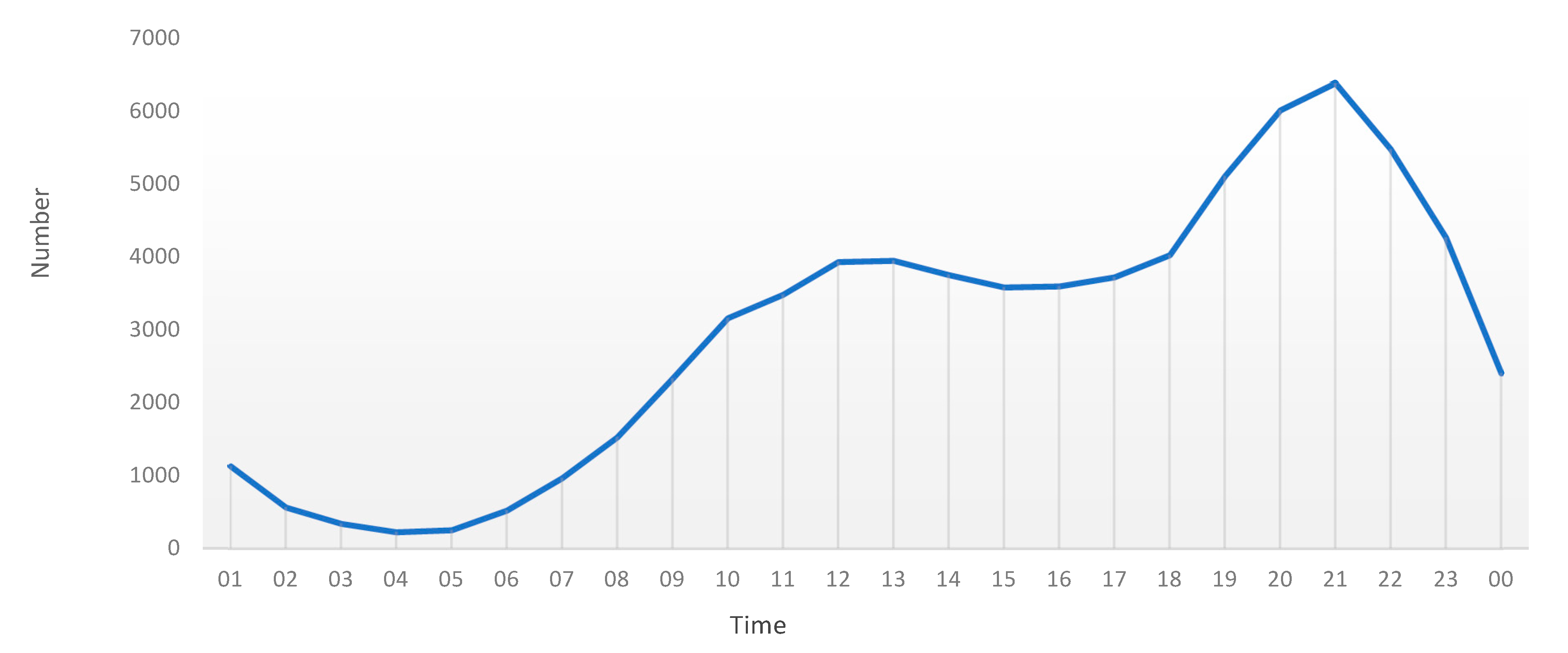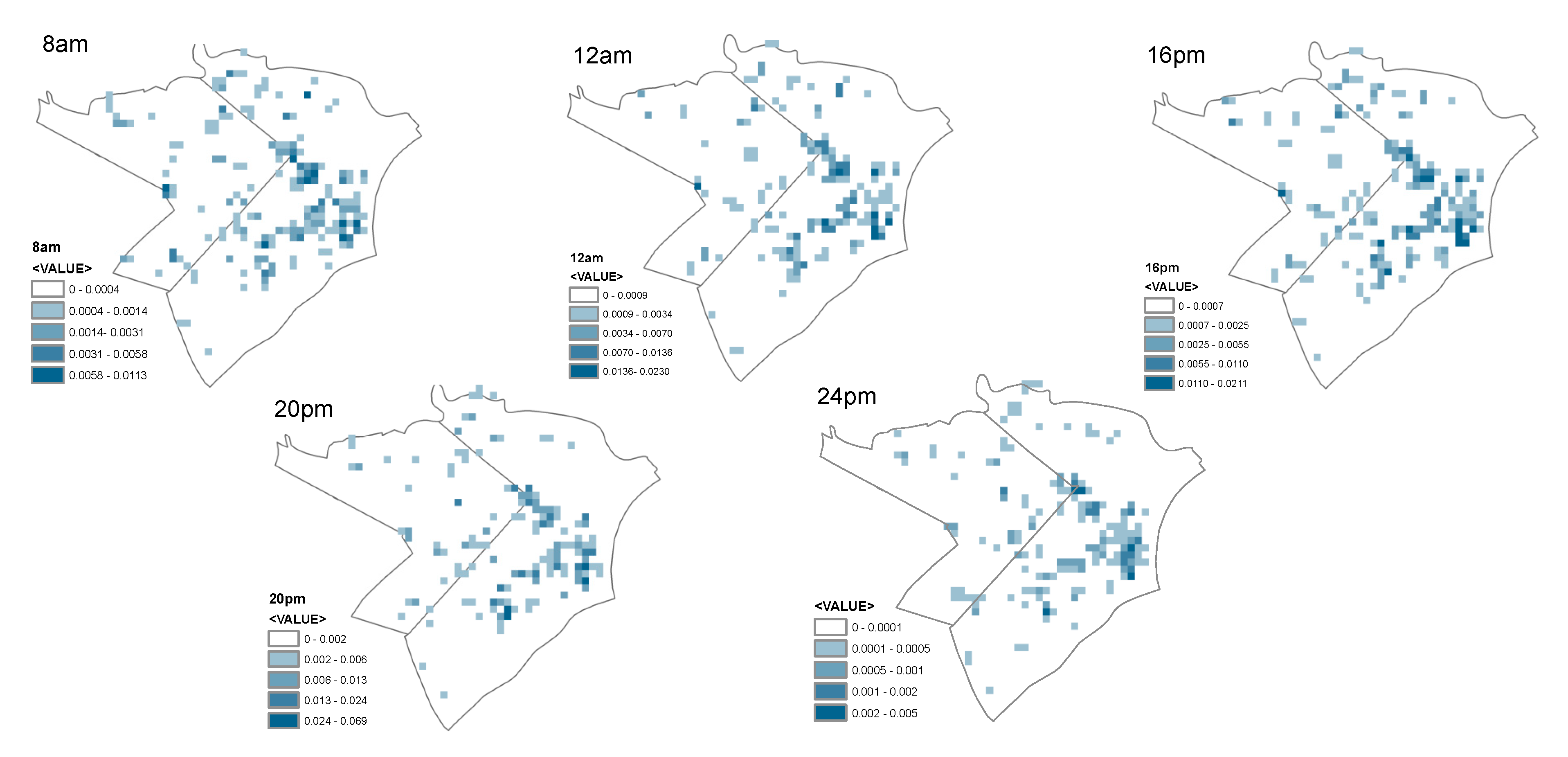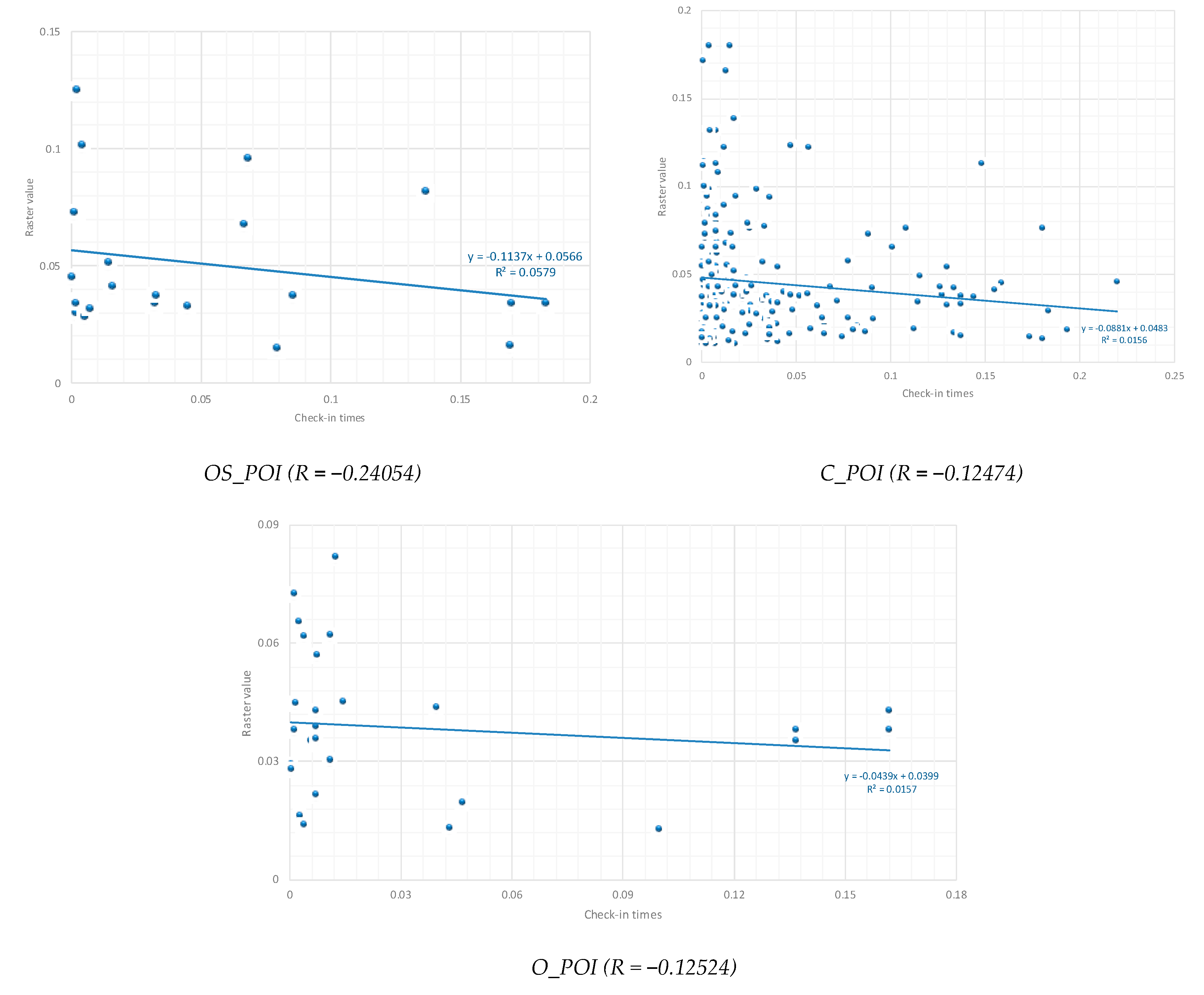Role of Urban Public Space and the Surrounding Environment in Promoting Sustainable Development from the Lens of Social Media
Abstract
:1. Introduction
2. Literature Review
2.1. Urban Public Space (UPS)
2.2. Geo-Tagged Social Media-Related Study
3. Methods
3.1. Analysis of Spatial Distribution Patterns
3.2. Indicators of UPSs’ Visitation Rates
3.3. Correlation Coefficient Modelling
4. Materials
4.1. Case Study
4.2. Data Collection
5. Data Analysis
5.1. Spatial Distribution of the Most Popular Spaces
5.2. Temporal Mobility Patterns
5.3. Kernel Density Estimation of Temporal–Spatial Distribution of the Popular Spaces
5.4. Correlation Coefficient
6. Discussion and Conclusions
7. Data Availability Statement
- Point of interest data of Ho Chi Minh City collected from the Google map in 2017.
- Check-in database collected from Instagram in 2016 and 2017 in Ho Chi Minh City.
- Street map of Ho Chi Minh City collected in Open Street Map.
Author Contributions
Funding
Acknowledgments
Conflicts of Interest
References
- Dick, H.; Rimmer, P. Beyond the Third World City: The New Urban Geography of South-east Asia. Urban Stud. 1998, 35, 2303–2321. [Google Scholar] [CrossRef]
- Shatkin, G. The City and the Bottom Line: Urban Megaprojects and the Privatization of Planning in Southeast Asia. Environ. Plan. A Econ. Space 2008, 40, 383–401. [Google Scholar] [CrossRef]
- Madaniour, A. Why are the design and developement of public spaces significant for cities? Environ. Plan. B Plan. Des. 1999, 26, 879–891. [Google Scholar] [CrossRef]
- Carr, S.; Francis, M.; Rivlin, L.G.; Stone, A.M. Public Space; Cambridge University Press: Cambridge, UK, 1992. [Google Scholar]
- Afacan, Y. Achieving Inclusion in Public Spaces: A Shopping Mall Case Study. In Designing Inclusive Systems; Springer: Berlin/Heidelberg, Germany, 2012; pp. 85–92. [Google Scholar]
- Akkar Ercan, Z.M. Public spaces of post-industrial cities and their changing roles. METU J. Fac. Archit. 2007, 24, 115–137. [Google Scholar]
- Chang, H.S.; Liao, C.H. Exploring an intergrated method for measuring the relative spatial equity im public facilities in the context of urban parks. Cities 2011, 28, 361–371. [Google Scholar] [CrossRef]
- Kazemi, A.V.; Dousti, F.; Behzadfar, M. A New Reading of Sociable Public Spaces: The Nexus between Urban Design and Microsociology. Armanshaltr Archit. Urban Dev. 2018, 11, 39–49. [Google Scholar]
- Rung, A.L.B.; Mowen, A.; Cohen, D.A. The significance of parks to physical activity and public health: A conceptual model. Am. J. Prev. Med. 2005, 28, 159–168. [Google Scholar] [CrossRef]
- Ding, D.; Sallis, J.F.; Kerr, J.; Lee, S.; Rosenberg, D.E. Neighborhood environment and physical activities among youth. American Journal of Preventive Medicine. 2014, 41, 442–455. [Google Scholar] [CrossRef]
- Ghavampour, E. The Contribution of Natural Design Elements to the Sustained Use of Public Space in a City Centre. Ph.D. Thesis, Victoria University of Wellington, Wellington, New Zeland, 2014. [Google Scholar]
- Aspinall, P. On environmental preference: applying conjoint analysis to visiting parks and buying houses. In Innovative Approaches to Research Landscape and Health: Open Space: People Space 2; Routledge: Abingdon, UK, 2010. [Google Scholar]
- Kaplan, R. The role of nature in the urban context. In Environment and Behaviroural Studies; Altman, I., Christensen, K., Eds.; Pelnum Press: New York, NY, USA, 1983. [Google Scholar]
- Koohsari, M.J.; Kaczynski, A.T.; Giles-Corti, B.; Karakiewicz, J.A. Effects of access to public open spaces on walking: Is proximity enough? Landsc. Urban Plan. 2013, 117, 92–99. [Google Scholar] [CrossRef]
- Schipperijn, J.; Stigsdotter, U.K.; Randrup, T.B.; Troelsen, J. Influences on the use of urban green space – A case study in Odense, Denmark. Urban For. Urban Green. 2010, 9, 25–32. [Google Scholar] [CrossRef]
- Tzoulas, K.; Korpela, K.; Yli-Pelkonen, V.; Kazmierczak, A.; Niemela, J.; James, P. Promoting ecosystem and human health in urban areas using green infrastrucutre: A literature review. Landsc. Urban Plan. 2007, 81, 167–168. [Google Scholar] [CrossRef]
- Chen, Y.; Liu, T.; Xie, X.; Marusic, B.G. What attracts people to visit community open spaces? A case study of the overseas Chinese town community in Shanzhen, China. Environ. Res. Public Health 2016, 13, 644. [Google Scholar] [CrossRef] [PubMed]
- Coutts, C. Multiple Case Studies of the Influence of Land-Use Type on the Distribution of Uses along Urban River Greenways. J. Urban Plan. Dev. 2009, 135, 31–38. [Google Scholar] [CrossRef]
- Han, H.; Sahito, N.; Nguyen, T.V.T.; Hwang, J.; Asif, M.; Nguyen, T.T. Exploring the Features of Sustainable Urban Form and the Factors that Provoke Shoppers towards Shopping Malls. Sustainability 2019, 11, 4798. [Google Scholar] [CrossRef]
- Kaczynski, A.T.; Potwarka, L.R.; Smale, B.J.A.; Havitz, M.E. Association of Parkland Proximity with Neighborhood and Park-based Physical Activity: Variations by Gender and Age. Leis. Sci. 2009, 31, 174–191. [Google Scholar] [CrossRef]
- Sugiyama, T.; Gunn, L.D.; Christian, H.; Francis, J.; Foster, S.; Hooper, P.; Owen, N.; Giles-Corti, B. Quality of Public Open Spaces and Recreational Walking. Am. J. Public Health 2015, 105, 2490–2495. [Google Scholar] [CrossRef]
- Brown, G. Mapping spatial attributes in survey research for natural resource managerment: Methods and applications. Soc. Nat. Res. 2005, 18, 17–39. [Google Scholar] [CrossRef]
- Gehl, J.; Richard, L.R. Cities for People; Island Press: Washington, DC, USA, 2013. [Google Scholar]
- Abaza, M. Shopping Malls, Consumer Culture and the Reshaping of Public Space in Egypt. Theory Cult. Soc. 2001, 18, 97–122. [Google Scholar] [CrossRef]
- Stillerman, J.; Salcedo, R. Transposing the Urban to the Mall: Routes, Relationships, and Resistance in Two Santiago, Chile, Shopping Centers. J. Contemp. Ethnigr. 2012, 41, 309–336. [Google Scholar] [CrossRef]
- Sui, D.; Goodchild, M. The convergence of GIS and Social media: Challenges for GISscience. Int. J. Geogr. Inf. Sci. 2011, 25, 1737–1748. [Google Scholar] [CrossRef]
- Croitoru, A.; Wayant, N.; Crooks, A.; Radzikowski, J.; Stefanidis, A. Linking cyber and physical spaces through community detection and clustering in social media feeds. Comput. Environ. Urban Syst. 2014, 53, 47–64. [Google Scholar] [CrossRef]
- Lin, J.; Cromley, R.G. Evaluating geo-located Twitter data as a control layer for areal interpolation of population. Appl. Geogr. 2015, 58, 41–47. [Google Scholar] [CrossRef]
- Shelton, T.; Poorthuis, A.; Graham, M.; Zook, M. Mapping the data shadows of Hurricane Sandy: Uncovering the cocial soatial dimensions of big data. Geoforum 2014, 52, 167–179. [Google Scholar] [CrossRef]
- Boyd, D.; Crawford, K. Critical questions for big data: provocations for a culture, technological, and scholarly phenomenon. Inf. Commun. Soc. 2012, 15, 662–679. [Google Scholar] [CrossRef]
- Martí, P.; Serrano-Estrada, L.; Nolasco-Cirugeda, A. Using locative social media and urban cartographies to identify and locate successful urban plazas. Cities 2017, 64, 66–78. [Google Scholar] [CrossRef]
- Zhai, S.; Xu, X.; Yang, L.; Zhou, M.; Zhang, L.; Qiu, B. Mapping the popurarity of urban restaurants using social media data. Appl. Geogr. 2015, 63, 113–120. [Google Scholar] [CrossRef]
- Lane, N.D.; Eisenman, S.B.; Miluzzo, E.; Compbell, A.T. Urban sensing systems. In Proceedings of the 9th Workshop on Mobile Computing Systems and Applications—Hot Mobile, Napa Valley, CA, USA, 25–26 February 2008. [Google Scholar]
- Noulas, A. Human Urban Mobility in Location-Based Social Networks: Analysis, Models and Applications; University of Cambridge: Cambridge, UK, 2013. [Google Scholar]
- Silva, T.H.; De Melo, P.O.S.V.; Almeida, J.M.; Salles, J.; Loureiro, A.A.F. A comparison of Foursquare and Instagram to the study of city dynamics and urban social behavior. In Proceedings of the 2nd ACM SIGKDD International Workshop, Chicago, IL, USA, 11 August 2013. [Google Scholar]
- Setha, L.; Taplin, D.; Scheld, S. Rethinking Urban Parks: Public Space and Cultural Diversity; University of Texas Press: Austin, TX, USA, 2005. [Google Scholar]
- Oldenburg, R. The Great Good Place; Marlowe: New York, NY, USA, 1999. [Google Scholar]
- Nguyen, T.V.T.; Han, H.; Sahito Nand Lam, N.T. The Bookstore-Café: Emergence of a New Lifestyle as a Third Place in Hangzhou, China. Space Cult. 2019, 22, 216–233. [Google Scholar] [CrossRef]
- Low, S.; Smith, N. The Politics of Public Space; Routledge: New York, NY, USA, 2006. [Google Scholar]
- Banerjee, T. The Future of Public Space:Beyond Invented Streets and Reinvented Places. J. Am. Plan. Assoc. 2001, 67, 9–24. [Google Scholar] [CrossRef]
- Stock, K. Mining location from social media: A systematic review. Comput. Environ. Urban Syst. 2018, 71, 209–240. [Google Scholar] [CrossRef]
- Song, C.; Koren, T.; Wang, P.; Barabasi, A.-L. Modelling the scaling properties of human mobility. Nat. Phys. 2010, 6, 818–823. [Google Scholar] [CrossRef] [Green Version]
- Xiao, G.; Juan, Z.; Zhang, C. Travel mode detection based on GPS track data and Bayesian networks. Comput. Environ. Urban Syst. 2015, 54, 14–22. [Google Scholar] [CrossRef]
- Tsou, M.-H.; Leitner, M. Visualization of social media: seeing a mirage or a message? Cartogr. Geogr. Inf. Sci. 2013, 40, 55–60. [Google Scholar] [CrossRef]
- Preotiuc-Peotro, D.; Cohn, T. Mining user behaviours: A case study of check-in patterns in location based social networks. In Proceedings of the 5th Annual ACM Science Conference, Paris, France, 2–4 May 2013. [Google Scholar]
- Frias-Martinez, V.; Soto, V.; Hohwald, H.; Frias-Martinez, E. Characterizing Urban Landscapes Using Geolocated Tweets. In Proceedings of the 2012 International Conference on Privacy, Security, Risk and Trust and 2012 International Confernece on Social Computing, Amsterdam, The Netherlands, 3–5 September 2012; pp. 239–248. [Google Scholar]
- Xia, C.; Hu, J.; Zhu, Y.; Naaman, M. What Is New in Our City? A Framework for Event Extraction Using Social Media Posts. In Proceedings of the Computer Vision—ECCV 2012, Firenze, Italy, 7–13 October 2012; Springer: Berlin/Heidelberg, Germany, 2015; Volume 9077, pp. 16–32. [Google Scholar]
- Hyvärinen, O.; Saltikoff, E. Social Media as a Source of Meteorological Observations. Mon. Weather Rev. 2010, 138, 3175–3184. [Google Scholar] [CrossRef]
- Boy, J.D.; Uitermark, J. How to Study the City on Instagram. PLoS ONE 2016, 11, e0158161. [Google Scholar] [CrossRef]
- Candia, J.; González, M.C.; Wang, P.; Schoenharl, T.; Madey, G.; Barabasi, A.-L. Uncovering individual and collective human dynamics from mobile phone records. J. Phys. A Math. Theor. 2008, 41, 224015. [Google Scholar] [CrossRef]
- O’Sullivan, D.; Unwin, D. Geographic Information Analysis; John Wiley & Sons: Hoboken, NJ, USA, 2003. [Google Scholar]
- Agterberg, F.P. Interactive Spatial Data Analysis. Comput. Geosci. 1996, 22, 953–954. [Google Scholar] [CrossRef]
- Silverman, B.W. Density Estimation for Statistics and Data Analysis; Chapman and Hall: London, UK, 1999. [Google Scholar]
- Schabenberger, O.; Gotway, C.A. Statistical Methods for Spatial Data Analysis; Chapman and Hall: London, UK, 2017. [Google Scholar]
- Miyake, K.K.; Maroko, A.R.; Grady, K.L.; Maantay, J.A.; Arno, P.S. Not Just a Walk in the Park: Methodological Improvements for Determining Environmental Justice Implications of Park Access in New York City for the Promotion of Physical Activity. Cities Environ. 2010, 3, 1–17. [Google Scholar] [CrossRef]
- Correlation Coefficient: Simple Definition, Formula, Easy Steps. 2019. Available online: http://www.statisticshowto.datasciencecentral.com/probability-and-statistics/correlation-coefficient-formula/ (accessed on 10 September 2019).
- Waibel, M. Ho Chi Minh Mega City; Regio Spectra Verlag: Berlin, Germany, 2013. [Google Scholar]
- Long, Y.; Huang, C.C. Does block size matter? The impact of urban design on economic vitality for Chinese cities. Environ. Plan. B Urban Anal. City Sci. 2019, 46, 406–422. [Google Scholar] [CrossRef]
- Donahue, M.L.; Keeler, B.L.; Wood, S.A.; Fisher, D.M.; Hamstead, Z.A.; McPhearson, T. Using social media to understand drivers of urban park visitation in the Twin Cities. Landsc. Urban Plan. 2018, 175, 1–10. [Google Scholar] [CrossRef]
- Curran, K.; Fisher, G.; Crumlish, J. OpenStreetMap. Int. J. Interact. Commun. Syst. Technol. 2012, 2, 69–78. [Google Scholar] [CrossRef]
- Shen, Y.; Karimi, K. Urban function connectivity: Characterisation of functional urban streets with social media check-in data. Cities 2016, 55, 9–21. [Google Scholar] [CrossRef] [Green Version]
- Duggan, M. Mobile Messaging and Social Media. 2015. Available online: https://www.pewinternet.org/2015/08/19/mobile-messaging-and-social-media-2015/ (accessed on 19 August 2015).
- Carmona, M. Contemporary public space, part two: Classsification. J. Urban Des. 2010, 15, 123–148. [Google Scholar] [CrossRef]
- Wu, L.; Zhi, Y.; Sui, Z.; Liu, Y. Intra-Urban Human Mobility and Activity Transition: Evidence from Social Media Check-In Data. PLoS ONE 2014, 9, e97010. [Google Scholar] [CrossRef] [PubMed]
- Prem, C.; Robert, S.; John, W. Modelling the Factors of Neighbourhood Attractiveness Reflected in Residential Location Decision Choices. Stud. Reg. Sci. 2006, 36, 393–417. [Google Scholar] [Green Version]








| Activity Category | Type of Visited Location |
|---|---|
| Open Space | Park, Square, Playground, Streets, etc. |
| Food & Drink | Coffee shop, Tea house, Restaurant, Pizza, Pub, Nightclub, Bar. |
| Life Service | Gym, Spa, Nail, Salon, etc. |
| Art & Entertainment | Entertainment, Theater, Concert Hall, Event Space, etc. |
| Shopping | Supermarket, Plaza, Pharmacy, Mall, Boutique, Bookstore, etc. |
| Residence and Office | Residential building, Office, etc. |
| Education | School, College, University, etc. |
© 2019 by the authors. Licensee MDPI, Basel, Switzerland. This article is an open access article distributed under the terms and conditions of the Creative Commons Attribution (CC BY) license (http://creativecommons.org/licenses/by/4.0/).
Share and Cite
Nguyen, T.V.T.; Han, H.; Sahito, N. Role of Urban Public Space and the Surrounding Environment in Promoting Sustainable Development from the Lens of Social Media. Sustainability 2019, 11, 5967. https://doi.org/10.3390/su11215967
Nguyen TVT, Han H, Sahito N. Role of Urban Public Space and the Surrounding Environment in Promoting Sustainable Development from the Lens of Social Media. Sustainability. 2019; 11(21):5967. https://doi.org/10.3390/su11215967
Chicago/Turabian StyleNguyen, Thuy Van T., Haoying Han, and Noman Sahito. 2019. "Role of Urban Public Space and the Surrounding Environment in Promoting Sustainable Development from the Lens of Social Media" Sustainability 11, no. 21: 5967. https://doi.org/10.3390/su11215967





